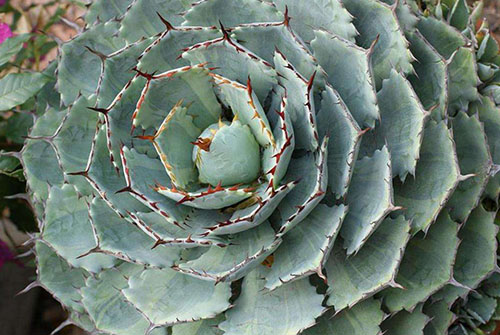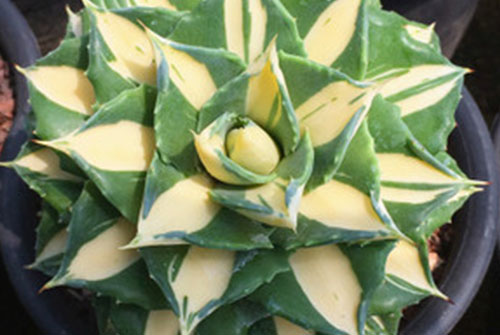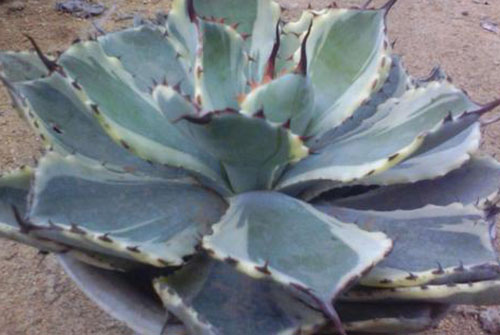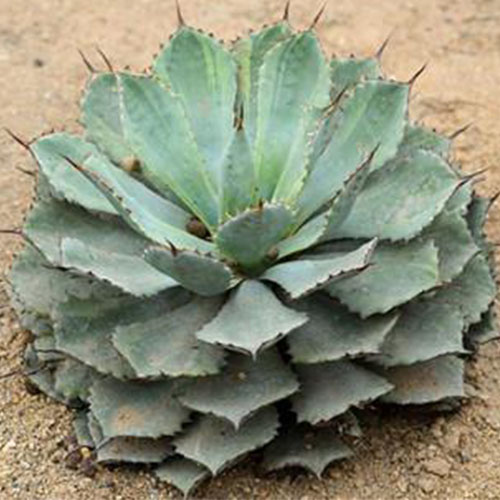Agavaceae breeding methods and precautions
Written by Maggie
Nov 12 2020

Agavaceae belong to the agave family and the genus agave. It is a perennial herbaceous succulent plant and an excellent indoor potted foliage plant.
Agavaceae picture

1. Characteristics and growth habits
Agavaceae plants are short. The leaf base is clustered and arranged in rosettes. The leaves are ovate and spoon-shaped, 20-25 cm long and 9-11 cm wide. The base is narrow, thick, off-white or light blue, with dark brown spines on the tip and edge of the leaf, and the edge of the leaf is serrated. No petiole. It is easy to grow seedlings around the plant and dip into it. The inflorescence is 3 meters high, and the flower diameter is about 5 cm, yellow-green.
Strong adaptability, more cold-tolerant, slightly shade-tolerant, afraid of waterlogging. The suitable temperature for growth is 15-25℃, and it requires a deep, fertile, well-drained sandy soil. Like a warm, dry and sunny environment. There is a certain resistance to negative.
2. Reproduction method
Agavaceae are mostly used cuttings or ramets. The base of the stem is easy to tiller and grow young plants. You can split the young plants when changing pots in spring and cut them separately.
3. Cultivation management
Plant or change pots in spring. Potted plants are mostly used for wintering indoors. The potting soil is required to be loose and fertile. It can be cultivated soil mixed with leaf rot, garden soil, coarse sand, etc. It is better to add a proper amount of decomposed organic cake fertilizer. No need to change pots frequently. When the root system in the soil is overgrown and affects watering, the soil should be replaced in time, and some old roots and dead roots should be cut off to facilitate growth.
1. Characteristics and growth habits
Agavaceae plants are short. The leaf base is clustered and arranged in rosettes. The leaves are obovate and spoon-shaped, 20-25 cm long and 9-11 cm wide. The base is narrow, thick, off-white or light blue, with dark brown spines on the tip and edge of the leaf, and the edge of the leaf is serrated. No petiole. It is easy to grow seedlings around the plant and dip into it. The inflorescence is 3 meters high, and the flower diameter is about 5 cm, yellow-green.
Strong adaptability, more cold-tolerant, slightly shade-tolerant, afraid of waterlogging. The suitable temperature for growth is 15-25℃, and it requires a deep, fertile, well-drained sandy soil. Like a warm, dry and sunny environment. There is a certain resistance to negative.
2. Reproduction method
Agavaceae are mostly used cuttings or ramets. The base of the stem is easy to tiller and grow young plants. You can split the young plants when changing pots in spring and cut them separately.
3. Cultivation management
Plant or change pots in spring. Potted plants are mostly used for wintering indoors. The potting soil is required to be loose and fertile. It can be cultivated soil mixed with leaf rot, garden soil, coarse sand, etc. It is better to add proper amount of decomposed organic cake fertilizer. No need to change pots frequently. When the root system in the soil is overgrown and affects watering, the soil should be replaced in time, and some old roots and dead roots should be cut off to facilitate growth.
It is not suitable for outdoor cultivation. Thor likes abundant and soft sunlight. The moisture should be properly controlled. During the growth period, in addition to being particularly hot in summer and requiring shade and avoiding direct sunlight, it is generally placed in a sunny, warm and dry environment. Keep the pot soil dry in winter, put it in the room and keep the temperature above 4℃.
4. Watering
Agavaceae likes dry soil environment and has strong drought tolerance. During the growth period, watering should be properly controlled. The principles of "Never dry or water, pour it out" and "Never dry but not wet" should be followed. Avoid frequent watering. If the basin soil is wet and waterlogged, the leaves will turn yellow. Root system rots. But it should not be too dry, otherwise the plant will grow slowly or even stop; the leaves will become dull and lack luster. In summer, watering should be increased appropriately, and 7JC should be sprayed more to the plants to keep the leaves green. During winter dormancy, watering should be controlled more to keep the pot soil in a relatively dry state. Low temperature and too wet pot soil are not good for the safe overwintering of plants.

5. Fertilization
Agavaceae are resistant to barrenness, and because of their small growth, there is not much demand for fertilizers. Apply fertilizer combined with nitrogen, phosphorus and potassium once a month to make the plants grow stronger and make the reddish-brown needles and beautiful markings more vivid. Pay attention to "thin fertilizer and more" when applying fertilizer, and avoid applying thick fertilizer (thick fertilizer). Fat is easy to damage the root). After autumn, people apply phosphorus and potassium fertilizer 1 to 2 times, and stop applying nitrogen fertilizer, which can help the plants to survive the winter safely. Stop fertilizing during winter dormancy.
6, trim
Most succulent pruning is relatively simple, and Thor is the same. When the old leaves at the base are withered, just cut them off in time.
7, turn over
Due to its slow growth, Agavaceae do not need to change pots frequently. Only when there are more tillers growing on the rhizomes, it is necessary to repot, generally once every 2 to 3 years. Repotting should be done in spring or early summer. When repotting, cut off some old roots and rotten roots, keep the new white roots, and replace them with new soil. Prefers fertile, loose and well-drained sandy loam with appropriate amount of calcareous soil. The matrix can be prepared with mulch, garden soil, coarse sand and other materials, and an appropriate amount of bone meal or shell powder and other calcareous materials are added. It is best to use coarse-grained red jade soil (a kind of soil for planting originally produced in Japan) for the precious varieties such as the king concubine Raytheon brocade.
8. Pest control
Agavaceae have leaf spot, anthracnose, gray mold, scale insects, whitefly and other pests. Sometimes leaf spot damage occurs, and Bordeaux mixture (1:1:100) can be sprayed multiple times for prevention and treatment. Insect pests are caused by scale insects and whiteflies, which can be sprayed with 40{bf} omethoate 1500 times liquid.
Agavaceaeis not suitable for outdoor cultivation. Thor likes abundant and soft sunlight. The moisture should be properly controlled. During the growth period, in addition to being particularly hot in summer and requiring shade and avoiding direct sunlight, it is generally placed in a sunny, warm and dry environment. Keep the pot soil dry in winter, put it in the room and keep the temperature above 4℃.
4. Watering
Agavaceae likes dry soil environments and has strong drought tolerance. During the growth period, watering should be properly controlled. The principles of "Never dry or water, pour it out" and "Never dry but not wet" should be followed. Avoid frequent watering. If the basin soil is wet and waterlogged, the leaves will turn yellow. Root system rots. But it should not be too dry, otherwise the plant will grow slowly or even stop; the leaves will become dull and lackluster. In summer, watering should be increased appropriately, and 7JC should be sprayed more to the plants to keep the leaves green. During winter dormancy, watering should be controlled more to keep the pot soil in a relatively dry state. Low temperature and too wet pot soil are not good for the safe overwintering of plants.
5. Fertilization
Agavaceae are resistant to barrenness, and because of their small growth, there is not much demand for fertilizers. Apply fertilizer combined with nitrogen, phosphorus and potassium once a month to make the plants grow stronger and make the reddish-brown needles and beautiful markings more vivid. Pay attention to "thin fertilizer and more" when applying fertilizer, and avoid applying thick fertilizer (thick fertilizer). Fat is easy to damage the root). After autumn, people apply phosphorus and potassium fertilizer 1 to 2 times, and stop applying nitrogen fertilizer, which can help the plants to survive the winter safely. Stop fertilizing during winter dormancy.

6, trim
Most succulent pruning is relatively simple, and Thor is the same. When the old leaves of Agavaceae at the base are withered, just cut them off in time.
7, turn over
Due to its slow growth, Agavaceae do not need to change pots frequently. Only when there are more tillers growing on the rhizomes, it is necessary to repot, generally once every 2 to 3 years. Repotting should be done in spring or early summer. When repotting, cut off some old roots and rotten roots of Agavaceae, keep the new white roots, and replace them with new soil. Prefers fertile, loose and well-drained sandy loam with appropriate amount of calcareous soil. The matrix can be prepared with mulch, garden soil, coarse sand and other materials, and an appropriate amount of bone meal or shell powder and other calcareous materials are added. It is best to use coarse-grained red jade soil (a kind of soil for planting originally produced in Japan) for the precious varieties such as the king concubine Raytheon brocade.
8. Pest control
Agavaceae have leaf spot, anthracnose, gray mold, scale insects, whitefly and other pests. Sometimes leaf spot damage occurs, and Bordeaux mixture (1:1:100) can be sprayed multiple times for prevention and treatment. Insect pests are caused by scale insects and whiteflies, which can be sprayed with 40{bf} omethoate 1500 times liquid.
Latest Updated
- Benefits of Bugleweed - 7 Science-backed Health Benefits
- Bugleweed Dangers & Side Effects - Is It Poisonous?
- How to Plant Evergreen Trees - What You Should Know
- When to Plant Evergreens - Grow Guide for Evergreen Trees
- 12 Wonderful Evergreen Shrubs for Your Garden
- 12 Popular Evergreen Plants with Pictures for Beginners
- When And How To Prune A Lilac Bush Like a Pro
- How to Grow & Care for Lilac Vine (Hardenbergia Violacea)
- Japanese Lilac Tree (Syringa Reticulata) Care & Propagation Guide
- Shumard Oak Pros and Cons - What to Know
Popular Articles
- Winter maintenance of Antirrhinum Majus
- How to Grow Terminalia Mantaly Tree
- How to Grow and Care for Crossostephium Chinense
- How to grow Antirrhinum Majus in spring
- Peristeria Elata (Dove Orchid) Profile: Info & Care Guide
- Underwatered Snake Plant (Sansevieria Trifasciata) - Signs And How To Fix
- How to Care for Brazilian Jasmine Plant (Mandevilla Sanderi)
- How to Grow & Care for Graptopetalum Purple Delight in Summer
- Rosa Chinensis (China Rose): Plant Growing & Care Tips
- How to Care for Baby Sun Rose (Aptenia Cordifolia)